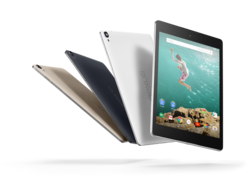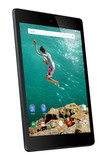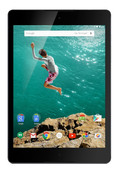First Impressions: Google Nexus 9 in Review

For the original German article, see here.
We want to give you our first impressions and benchmark results before the in-depth review of the Google Nexus 9 follows in a couple of days. With the new tablet, which is now produced by HTC, the seven and ten-inch tablets disappear from the Internet giant’s portfolio. As the new device is right in between, with an 8.9-inch display, this step is not unreasonable. Nvidia's Tegra K1 SoC, which uses a 64-bit architecture for the first time, suggests high performance, and the brand-new operating system Android 5.0 Lollipop finally delivers the corresponding environment.
Google has raised the price significantly. While the Nexus 7 had a starting price of 229 Euros ~$285), the Nexus 9 costs at least 389 Euros (~$485; Wi-Fi, 16 GB) and is therefore on par with the iPad Mini 3 (Wi-Fi, 16 GB). The RRP of Samsung's Galaxy Tab S 8.4 (Wi-Fi, 16 GB) is even more expensive with another 10 Euros (~$12) extra, but the retail price is actually lower by now.
Initial Impressions
At almost eight millimeters (~0.3 inches), the Google Nexus 9 is slightly thicker than the other premium devices. The weight of 422 grams (~14.8 ounces) is not too high, but it is noticeably heavier than the iPad Mini 3 (331 g; ~11.67 ounces) and the Tab S 8.4 (301 g; ~10.6 ounces). It is much wider and therefore harder to hold with one hand. Even though the choice of materials is limited to plastic, the tablet does not leave a cheap impression and is actually comfortable to hold. However, the torsion resistance does not seem to be very good, even gentle attempts to twist the device result in loud creaking sounds and part of the back cover is lifted.
The stereo speakers with Boom Sound surround the display in landscape mode and leave a pretty good initial impression. The connectivity specifications are very convenient as well, with support for the fast ac WLAN, Bluetooth 4.1 as well as NFC. Our review unit is Wi-Fi only, LTE is an option. The manufacturer does not integrate a fingerprint scanner.
Google's Android 5.0 Lollipop leaves a very good impression right away, and its modern design is very appealing. Only the keyboard layout is rather unusual at a first glance since there is no visual separation between the virtual keys. The system runs very smoothly, and we could not notice any stutters so far.
Cameras
The Google Nexus 9 has an 8 megapixels camera at the back, which is supported by an LED flash. The first sample pictures showed a big problem with back light. An HDR feature that could compensate for this issue does not seem to be available. In general, features are limited to the essentials. An auto focus is available, but you have to live without any kind of image stabilization.
The panorama mode is very versatile and can be used in landscape as well as portrait mode. It is also possible to create panoramas from multiple pictures.
Videos on the Nexus 9 are recorded in Full HD (1920x1080 pixels, 16:9, 30 fps). There is no slow-motion or time lapse function. It is also not possible to record Ultra HD movies, which is rather surprising.
Display
The Google Nexus 9 has an 8.9-inch display, which is protected by Corning Gorilla Glass 3. The resolution of 2048x1536 pixels is identical to the rival from Apple. A higher resolution, and therefore a higher pixel density is provided by the Galaxy Tab S 8.4 (2560x1600 pixels).
Brightness and brightness distribution are at a very good level, but the black value is slightly raised, which results in a pretty average contrast ratio. There were also many users of Google tablets that complained about visible screen bleeding. We can also confirm this problem at the edges with a completely black picture.
| |||||||||||||||||||||||||
Brightness Distribution: 92 %
Center on Battery: 430 cd/m²
Contrast: 558:1 (Black: 0.77 cd/m²)
ΔE Color 3.17 | 0.5-29.43 Ø5
ΔE Greyscale 3.29 | 0.57-98 Ø5.3
62% AdobeRGB 1998 (Argyll 1.6.3 3D)
Gamma: 2.39
| Google Nexus 9 GeForce ULP K1 (Tegra K1 Kepler GPU), K1 (Denver), 32 GB eMMC Flash | Google Nexus 7 2013 Adreno 320, S4 Pro APQ8064A, 16 GB SSD | Samsung Galaxy Tab S 8.4 Mali-T628 MP6, 5420 Octa, 16 GB eMMC Flash | Apple iPad Mini 3 PowerVR G6430, A7, 16 GB eMMC Flash | Amazon Kindle Fire HDX 7 inch Adreno 330, 800 MSM8974, 16 GB SSD | NVIDIA Shield Tablet P1761W GeForce ULP K1 (Tegra K1 Kepler GPU), K1, 16 GB iNAND Flash | |
|---|---|---|---|---|---|---|
| Screen | 6% | -1% | 1% | -33% | 4% | |
| Brightness middle | 430 | 548.7 28% | 258 -40% | 357 -17% | 446.9 4% | 455 6% |
| Brightness | 411 | 513 25% | 261 -36% | 344 -16% | 426 4% | 469 14% |
| Brightness Distribution | 92 | 87 -5% | 91 -1% | 86 -7% | 91 -1% | 92 0% |
| Black Level * | 0.77 | 1.07 -39% | 0.61 21% | 0.669 13% | 0.68 12% | |
| Contrast | 558 | 513 -8% | 585 5% | 668 20% | 669 20% | |
| Colorchecker dE 2000 * | 3.17 | 2.64 17% | 3.66 -15% | 3.35 -6% | 6.73 -112% | 3.88 -22% |
| Greyscale dE 2000 * | 3.29 | 2.61 21% | 2.51 24% | 2.09 36% | 8.52 -159% | 3.38 -3% |
| Gamma | 2.39 92% | 2.35 94% | 2.22 99% | 2.4 92% | 2.39 92% | 2.74 80% |
| CCT | 6746 96% | 6701 97% | 6450 101% | 6851 95% | 5710 114% | 6537 99% |
| Color Space (Percent of AdobeRGB 1998) | 62 | 100 61% | 55 -11% |
* ... smaller is better
Performance
The dual-core processor Nvidia Tegra K1 (Denver) has comparatively few cores for an Android device. However, they clock at 2.5 GHz, and support 64-bit, which result in a noticeably higher per-MHz performance. SoCs with four or more cores have an advantage when multiple cores are utilized. 2 GB of memory is not insufficient, and we expected more, considering the high-end claim and the 64-bit operating system.
The graphics solution is similar to the 32-bit version of the Tegra K1, is used in the Shield Tablet, for example. GFXBench 2.7 still shows a slightly worse result in the Offscreen test compared to the Nvidia tablet. We will check if this is caused by throttling in our in-depth review; the tablet was pretty warm at the back during the first GPU benchmarks.
The performance itself is great, and is among the best you can currently get. The storage in particular is the fastest module we have found in an Android device so far. HTC really shows what is possible with eMMC 4.51.
| Geekbench 3 | |
| 32 Bit Single-Core Score (sort by value) | |
| Google Nexus 9 | |
| Samsung Galaxy Tab S 8.4 | |
| Apple iPad Mini 3 | |
| Samsung Galaxy Note 4 | |
| NVIDIA Shield Tablet P1761W | |
| 32 Bit Multi-Core Score (sort by value) | |
| Google Nexus 9 | |
| Samsung Galaxy Tab S 8.4 | |
| Apple iPad Mini 3 | |
| Samsung Galaxy Note 4 | |
| NVIDIA Shield Tablet P1761W | |
| 3DMark | |
| 1280x720 offscreen Ice Storm Unlimited Score (sort by value) | |
| Google Nexus 9 | |
| Samsung Galaxy Tab S 8.4 | |
| Apple iPad Mini 3 | |
| Samsung Galaxy Note 4 | |
| NVIDIA Shield Tablet P1761W | |
| Apple iPad Air 2 2014 | |
| 1280x720 offscreen Ice Storm Unlimited Graphics Score (sort by value) | |
| Google Nexus 9 | |
| Samsung Galaxy Tab S 8.4 | |
| Apple iPad Mini 3 | |
| Samsung Galaxy Note 4 | |
| NVIDIA Shield Tablet P1761W | |
| Apple iPad Air 2 2014 | |
| 1280x720 offscreen Ice Storm Unlimited Physics (sort by value) | |
| Google Nexus 9 | |
| Samsung Galaxy Tab S 8.4 | |
| Apple iPad Mini 3 | |
| Samsung Galaxy Note 4 | |
| NVIDIA Shield Tablet P1761W | |
| Apple iPad Air 2 2014 | |
| GFXBench 3.0 | |
| on screen Manhattan Onscreen OGL (sort by value) | |
| Google Nexus 9 | |
| Samsung Galaxy Tab S 8.4 | |
| Apple iPad Mini 3 | |
| Samsung Galaxy Note 4 | |
| NVIDIA Shield Tablet P1761W | |
| Apple iPad Air 2 2014 | |
| 1920x1080 1080p Manhattan Offscreen (sort by value) | |
| Google Nexus 9 | |
| Samsung Galaxy Tab S 8.4 | |
| Apple iPad Mini 3 | |
| Samsung Galaxy Note 4 | |
| NVIDIA Shield Tablet P1761W | |
| Apple iPad Air 2 2014 | |
| Peacekeeper - --- (sort by value) | |
| Google Nexus 9 | |
| Google Nexus 7 2013 | |
| Samsung Galaxy Tab S 8.4 | |
| Samsung Galaxy Note 4 | |
| Apple iPad Air 2 2014 | |
| Octane V2 - Total Score (sort by value) | |
| Google Nexus 9 | |
| Samsung Galaxy Tab S 8.4 | |
| Apple iPad Mini 3 | |
| Samsung Galaxy Note 4 | |
| NVIDIA Shield Tablet P1761W | |
| Apple iPad Air 2 2014 | |
Energy and Battery Runtime
The idle consumption is comparatively high, which suggests a pretty high consumption of the display. However, HTC compensates this with a big 6900 mAh battery, so the high consumption should not be a problem. The battery runtimes should be on a good, or even very good level.
According to the manufacturer, the Nexus 9 is supposed to last for 9.5 hours during web browsing via WLAN, which is just slightly behind the iPad Mini 3 (10 hours). Android 5.0 Lollipop now finally has its own energy-saving mode that can be activated at a battery capacity of five or fifteen percent.
| Off / Standby | |
| Idle | |
| Load |
|
Preliminary Verdict
Google presents a strong tablet in cooperation with HTC, which creates high expectations because of the excellent predecessors. However, the pricing is the first small drawback.
The Nexus 9 is slightly bulkier than its rivals, but the design is still quite nice. However, the first hands-on has already revealed some build quality issues. The display has a very high resolution and is very bright, but the contrast could be better. The camera only offers the basic functions, but the resolution at least exceeds other tablets, and there is an LED flash.
Nvidia's Tegra K1 (Denver) leaves a great first impression with its excellent performance. We have to check a possible throttling of the GPU in our final review. We also really liked Google’s Android 5.0 Lollipop, which so far runs without any noticeable delays.
We also miss a storage extension via microSD card, especially since the Nexus 9 is only available with 16 GB or 32 GB internal storage. The tablet will have a hard time to get a very good rating. It is also a bit unfortunate that good devices like the Nexus 7 have been completely removed from the portfolio of the American manufacturer.


 Deutsch
Deutsch English
English Español
Español Français
Français Italiano
Italiano Nederlands
Nederlands Polski
Polski Português
Português Русский
Русский Türkçe
Türkçe Svenska
Svenska Chinese
Chinese Magyar
Magyar







